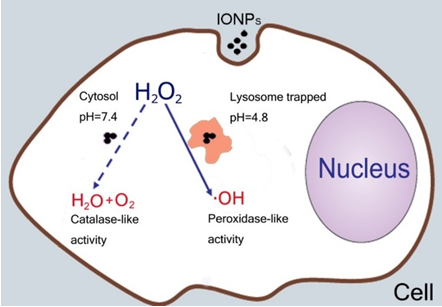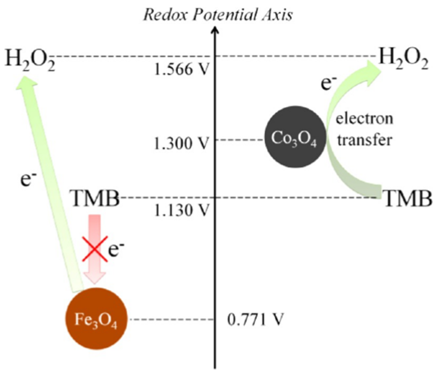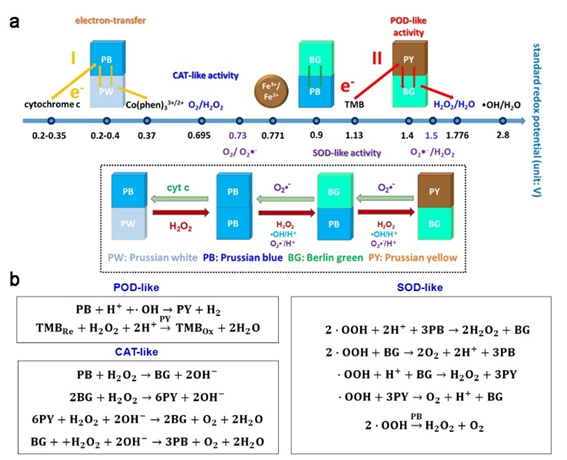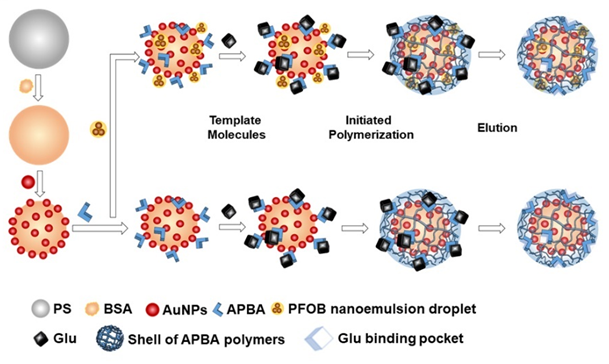
hotline:
17715390137
Tel/Wechat:
18101240246 (Technology)
0512-68565571
Email:mxenes@163.com (Sales Engineer)bkxc.bonnie@gmail.com
Scan the code to follow or search the official account on WeChat:
2D Materials Fronrier After paying attention,
click on the lower right corner to contact us,
Enter enterprise WeChat.
Professional Services Online

已传文件:photo/202072791544247.png
As a functional nanomaterial with mimic enzyme properties, nanoenzymes can not only overcome the shortcomings of natural enzymes such as poor stability and high production cost, but also have the designability, versatility, maneuverability and applicability of nanomaterials [1]. The research group of Gu Ning and Zhang Yu of Southeast University has made relevant research progress in the field of nanoenzymes, such as the study of the catalytic mechanism of iron oxide, cobalt oxide, Prussian blue, gold nanozymes, in vitro detection, imaging, cell protection and tumor treatment of nanozymes , Nanoenzyme related national standards, etc.
01 pH-dependent dual-enzyme-like activity of iron oxide nanoparticles
This study used electron spin resonance (ESR) technology to find for the first time that iron oxide nanoparticles (IONPs) have pH-dependent bienzyme-like activity: Under acidic conditions, IONPs can react with H2O2 to generate highly toxic hydroxyl radicals (· OH), showing peroxidase-like (POD) activity; under neutral conditions, it can catalyze the disproportionation reaction of H2O2, decomposing into non-toxic H2O and O2, showing catalase-like (CAT) activity [2] .
This study proves that the distribution of IONPs in cells and the intracellular microenvironment are important factors affecting their cytotoxicity. That is, when IONPs are localized in the lysosome, they will have a strong toxic effect; when they are localized in the cytoplasm, they will have a greater Good detoxification effect (Figure 1). Therefore, the lysosomal escape strategy is an effective method that is expected to reduce the long-term toxicity of IONPs.

Figure 1: pH-dependent POD and CAT-like activities of iron oxide nanoparticles
02 Multi-enzyme activity and charge transfer catalytic mechanism of cobalt tetroxide nanoparticles
This study proved that Co3O4 nanoparticles (Co3O4 NPs) have CAT, POD and SOD-like enzyme activities [4]. The use of electronic autoselective resonance technology to study its catalytic mechanism shows that the POD-like activity of Co3O4 NPs does not follow the Fenton-like reaction to produce ·OH, but the higher redox potential of Co3+/Co2+ makes Co3O4 NPs have strong oxidizing properties and can be used as The electron transfer medium directly transfers the electrons from TMB to H2O2 (Figure 2). Under neutral conditions, H2O2 tends to decompose slowly, and Co3O4 NPs help to accelerate this process, because the redox potential of H2O/O2 is very low, and H2O2 is easily oxidized by Co3+. Based on the strong POD-like activity of Co3O4 NPs, the author designed a new immunohistochemical method to couple the Avastin antibody to the surface of Co3O4 NPs, and the obtained conjugate was used to detect over-expressed vascular endothelial growth in tumor tissues Factor (VEGF).

Figure 2: The catalytic mechanism of Co3O4 NPs-like POD enzyme activity
03 Prussian blue nanoparticle multi-enzyme activity and active oxygen scavenging function
The generation of reactive oxygen species (ROS) is one of the important mechanisms of the toxicity of nanomaterials. Studies have found that Prussian blue nanoparticles (PBNPs) have multiple enzyme activities such as POD, CAT, and superoxide dismutase (SOD), and can effectively remove ROS [3]. Mechanism studies have shown that, unlike the Fenton-like reaction of iron oxide nanoparticles to produce ·OH, PBNPs can inhibit the production of ·OH. The author speculates for the first time that the multi-enzyme-like activity of PBNPs may be due to the rich redox potential of PBNPs, which makes them efficient electron transporters (Figure 3).
In order to study the ability of PBNPs to remove ROS, a series of in vitro ROS generation models were established, including chemical drug stimulation, lipopolysaccharide-induced inflammation, ultraviolet radiation, neuronal hypoxia and reoxygenation, etc. The addition of PBNPs can eliminate the generated ROS and effectively resist Oxidizes and improves cell activity, and is dose-dependent. At the same time, lipopolysaccharide was used to induce an inflammation model in mice, which also showed that Prussian blue nanoparticles can inhibit inflammation.

Figure 3: PBNPs-like multi-enzyme activity and its catalytic mechanism
04 Molecular imprinting improves the selectivity of gold nanoparticles like glucose oxidase
The lack of selectivity of nanoenzymes for catalytic substrates has always been one of the important factors restricting the replacement of natural enzymes by nanomaterials in practical applications, and it is also an important problem that domestic and foreign researchers are committed to solving. To this end, aminophenylboronic acid is used to bind the ortho hydroxyl of glucose molecules under alkaline conditions to imprint glucose molecules on the surface of gold nanoparticles (AuNPs). After elution, glucose molecular pockets are left on the surface of AuNPs.
Subsequently, aminophenylboronic acid is polymerized to form a molecularly imprinted shell. This strategy realizes the selectivity of AuNPs as an oxidase-like substrate to glucose (Figure 4). In addition, adding perfluorooctyl bromide with oxygen supply capability can further enhance the catalytic activity of AuNPs. Compared with pure AuNPs, the catalytic efficiency of oxygen-carrying AuNPs with glucose molecularly imprinted shells prepared in this work is increased by 270 times, and they have been successfully used for the detection of glucose content in actual samples (beverages, blood) [5].

Figure 4: Schematic diagram of the preparation of oxygen-carrying AuNPs with glucose molecularly imprinted shell
05 Prussian blue nanoenzyme used for dual-mode ultrasound-magnetic resonance imaging
The excessive production of H2O2 induced by ROS can be used as a potential diagnostic marker to judge the existence and progression of various pathological conditions. According to the CAT-like activity of PBNPs in neutral conditions that can catalyze the decomposition of H2O2 into O2, a high-sensitivity, high-resolution ultrasound and magnetic resonance dual-mode imaging probe based on PBNPs was developed for in vivo/external diagnosis of H2O2 ( Figure 5) [6].
The generation of oxygen bubbles changes the acoustic impedance of oxidatively stressed tissues, so that PBNPs can be used as ultrasound contrast agents to enhance ultrasound imaging. At the same time, the Fe3+ centers on the surface of the nanoparticles are easy to exchange with H2O and the paramagnetic oxygen bubbles can shorten the T1 relaxation time, so that PBNPs can also be used as T1 magnetic resonance contrast agents.

Figure 5: Schematic diagram of PBNPs used in ultrasound-magnetic resonance dual-mode imaging
06 Injectable supramolecular magnetic hydrogel: magnetocaloric nanoenzymes work together to treat tumors
In order to overcome the tolerance of tumor cells to heat stress in mild magnetic induction hyperthermia, this work innovatively introduces Fe3O4 nanoenzyme catalyzed therapy into magnetic induction hyperthermia, providing a new strategy for tumor synergistic therapy (Figure 6) .
In this work, PEG and α-cyclodextrin were used to construct supramolecular hydrogels with shear thinning effect and temperature-sensitive phase transition capabilities through the inclusion of PEG and α-cyclodextrin as a therapeutic platform, and 8 nm Fe3O4 nanoparticles modified with PEI were used as the magnetic heat source and Peroxidase-like enzymes [7]. The gel is injected into the tumor tissue, and an alternating magnetic field is applied to cause the Fe3O4 particles to generate heat to 42 °C. While the tumor tissue is being treated with hyperthermia, the gel is liquefied to promote the diffusion of the components in the gel between the tumor cells, and the gel The composite glucose-loaded nanocapsules react with glucose oxidase to produce higher concentration of H2O2. Fe3O4 particles play a mimic enzyme effect in the slightly acidic environment of tumors, and catalyze the production of H2O2 through Fenton reaction to kill tumor cells. In addition, the heat generated by hyperthermia can enhance the activity of Fe3O4 POD enzymes and produce more ·OH. ·OH further damages the highly expressed heat shock protein HSP 70 in hyperthermia, and improves the effect of hyperthermia.
This synergistic treatment based on magnetic nanoparticle magnetic induction hyperthermia and nano-enzymatic oxidation makes the tumor treatment effect remarkable. 42°C hyperthermia can subcutaneous tumors of breast cancer in mice.

Figure 6: Schematic diagram of injectable supramolecular hydrogel magnetic induction hyperthermia and nanoenzyme treatment of mouse tumors
07 Established a national standard for nanoenzymes: "Nano-technology iron oxide nanoparticles peroxidase activity measurement method"
With the continuous support of the national major scientific research plan and the national key research and development plan, the research, demonstration and review lasted for nearly five years, Southeast University cooperated with the Institute of Biophysics of the Chinese Academy of Sciences, the Institute of Basic Medicine of the Chinese Academy of Medical Sciences and Nanjing Dongna Biotechnology Co. The national standard "Nanotechnology Iron Oxide Nanoparticle Peroxidase Activity Measurement Method" (GB/T37966-2019), developed and drafted by other institutions, passed the final review organized by the National Nanotechnology Standardization Technical Committee, and was approved by the State Administration for Market Supervision, The National Standardization Administration of China approved the release and implementation [8].
This standard specifies the measurement method of iron oxide nanoparticle-like peroxidase activity, which is suitable for measuring and evaluating iron oxide nanoparticle-like peroxidase activity using a spectrophotometer. This standard can be used as a reference for measuring the activity of other types of nanoparticle-like peroxidases, and is of extremely important value for standardizing the scientific measurement method of nanoparticle-like enzyme activity in biomedical applications and breaking through the bottleneck of biomedical application transformation.
Measurement principle: This standard uses 3,3‘,5,5‘-tetramethylbenzidine (TMB) as the measurement substrate, and is catalyzed by iron oxide nanoparticles at 37°C and acidic conditions (pH=3.6). A TMB derivative that is oxidized by H2O2 to blue. The derivative has a characteristic absorption peak at a wavelength of 650nm. The absorbance of the reaction solution was detected at 37°C and 650nm wavelength over time, and the amount of TMB derivative produced per unit time was calculated according to Lambert Beer‘s law, so as to obtain the number of enzyme activity units (bnano) contained in the iron oxide  nanoparticles. Divide bnano by the iron mass of the added iron oxide nanoparticles to obtain the iron oxide nanoparticles-like peroxidase activity (anano).
nanoparticles. Divide bnano by the iron mass of the added iron oxide nanoparticles to obtain the iron oxide nanoparticles-like peroxidase activity (anano).
Figure 7: Schematic diagram of measuring the peroxidase activity of iron oxide nanoparticles
Although there has been a lot of work related to the development of new nanoenzymes or improving the activity of nanoenzymes through clever design in this field, nanoenzymes still face many challenges in order to become excellent substitutes for natural enzymes. There are still some urgent problems to be solved, such as: understanding of the catalytic nature of nanoenzymes, the complex relationship between the surface chemical properties of nanomaterials and catalytic activity, expanding the catalytic types of nanoenzymes, improving the selectivity of catalytic substrates, and related standards The formulation of nano-enzymes and the interaction of complex biological systems in the body.
Advanced characterization techniques and the cooperation of scientists in various fields are very necessary. Only with an in-depth and thorough understanding and solutions to these problems, nano "nova"-nano enzymes is expected to be used in medicine, food, chemical industry, agriculture, environment and other fields with clearer and unique advantages in the future. , To make greater contributions to the country’s industrial development and the improvement of people’s quality of life.
references:
[1] Dong H, Fan Y, Zhang W, et al. CatalyticMechanisms of Nanozymes and Their Applications in Biomedicine[J]. BioconjugateChemistry, 2019, 30(5): 1259-1584.
[2] Chen Z, Yin J J, Zhou Y T, et al. DualEnzyme-like Activities of Iron Oxide Nanoparticles and Their Implication forDiminishing Cytotoxicity[J]. ACS Nano, 2012, 6(5): 4001-4012.
[3] Zhang W, Hu S, Yin J J, et al. Prussian BlueNanoparticles as Multienzyme Mimetics and Reactive Oxygen SpeciesScavengers[J]. Journal of the American Chemical Society, 2016, 138(18): 5860-5865.
[4] Dong J, Song L, Yin JJ, et al. Co3O4Nanoparticles with Multi-Enzyme Activities and Their Application inImmunohistochemical Assay[J]. ACS Applied Materials & Interfaces, 2014,6(3): 2014, 6: 1959-1970 .
[5] Fan L, Wu H, Lou D, et al. A NovelAuNPs-based Glucose Oxidase Mimic with Enhanced Activity and SelectivityConstructed by Molecular Imprinting and O2-Containing NanoemulsionEmbedding[J]. Adv. Mater. Interfaces, 2018, 5, 1801070 .
[6] Yang F, Hu S, Zhang Y, et al. A HydrogenPeroxide-Responsive O2 Nanogenerator for Ultrasound and Magnetic-Resonance Dual Modality Imaging[J]. Advanced Materials, 2012, 24(38): 5205-5211.
[7] Wu H, Liu L, Song L, et al. Enhanced TumorSynergistic Therapy by Injectable Magnetic Hydrogel Mediated Generation of Hyperthermia and Highly Toxic Reactive Oxygen Species[J]. ACS Nano, 2019,13(12):14013-14023.
[8] National Standard: "Nanotechnology Iron Oxide Nanoparticle Peroxidase Activity Measurement Method" GB/T 37966-2019.
This information is sourced from the Internet for academic exchange only. If there is any infringement, please contact us to delete it immediately.

| Reminder: Beijing Beike New Material Technology Co., Ltd. supplies products only for scientific research, not for humans |
| All rights reserved © 2019 beijing beike new material Technology Co., Ltd 京ICP备16054715-2号 |